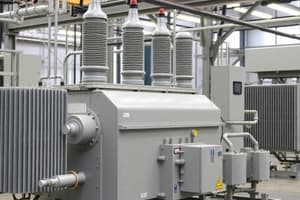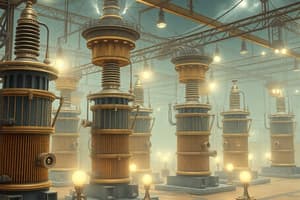Podcast
Questions and Answers
What is the primary function of a Step-Up Transformer?
What is the primary function of a Step-Up Transformer?
- Provides electrical isolation between circuits.
- Increases voltage from primary to secondary coil. (correct)
- Decreases voltage for residential use.
- Measures current flowing in a circuit.
Which transformer is typically used to safely power sensitive equipment?
Which transformer is typically used to safely power sensitive equipment?
- Distribution Transformer
- Current Transformer
- Isolation Transformer (correct)
- Step-Down Transformer
In a Step-Down Transformer, which statement is true?
In a Step-Down Transformer, which statement is true?
- It measures voltage in high-voltage systems.
- It increases voltage for transmission purposes.
- It has an equal number of turns in the primary and secondary coil.
- More turns are present in the primary coil than in the secondary. (correct)
What characterizes an Auto-Transformer?
What characterizes an Auto-Transformer?
Which statement best describes a Three-Phase Transformer?
Which statement best describes a Three-Phase Transformer?
What is the main purpose of a Current Transformer (CT)?
What is the main purpose of a Current Transformer (CT)?
What is a key feature of a Potential Transformer (PT)?
What is a key feature of a Potential Transformer (PT)?
What is the main role of a Distribution Transformer?
What is the main role of a Distribution Transformer?
Flashcards are hidden until you start studying
Study Notes
Types of Transformers
-
Step-Up Transformer
- Increases voltage from primary to secondary coil.
- More turns in the secondary coil than in the primary.
- Used in power plants to boost voltage for transmission.
-
Step-Down Transformer
- Decreases voltage from primary to secondary coil.
- More turns in the primary coil than in the secondary.
- Commonly used in power distribution to reduce voltage for residential use.
-
Isolation Transformer
- Provides electrical isolation between circuits.
- Typically has equal number of turns on primary and secondary.
- Used for safety in sensitive equipment or reducing noise.
-
Auto-Transformer
- Has a single winding that acts as both primary and secondary.
- Provides variable voltage output.
- More compact and efficient for small voltage adjustments.
-
Three-Phase Transformer
- Used in three-phase power systems.
- Can be built as a bank of three single-phase transformers or a single three-phase unit.
- Essential for large industrial applications and power distribution.
-
Current Transformer (CT)
- Measures current flowing in a circuit.
- Converts high current to a lower, manageable value.
- Commonly used in metering and protection of electrical systems.
-
Potential Transformer (PT)
- Measures voltage in high-voltage systems.
- Steps down voltage to a lower level for measurement and monitoring.
- Important for voltage monitoring in substations.
-
Distribution Transformer
- Used to distribute electricity at the final stage from the transmission system to end-users.
- Typically step-down transformers designed for low voltage applications.
- Optimized for efficiency and reliability in residential and commercial areas.
-
Power Transformer
- Used in transmission networks to transfer electrical energy between high voltages.
- Typically larger and designed for continuous operation.
- Essential for the long-distance transmission of electricity.
-
Phase-Shifting Transformer
- Used to control power flow in transmission systems.
- Adjusts phase angle to manage load distribution.
- Helps in balancing power across connected grids.
-
Variable Transformer
- Allows for adjustable output voltage.
- Often used for testing and laboratory applications.
- Can be manually or electronically controlled.
Conclusion
Transformers are critical components in electrical systems, each type serving specific functions, from voltage adjustment to current measurement, ensuring safe and efficient power distribution and usage.
Types of Transformers
-
Step-Up Transformer:
- Increases voltage from primary to secondary coil.
- Features more turns in secondary than primary.
- Essential in power plants for boosting voltage during transmission.
-
Step-Down Transformer:
- Lowers voltage from primary to secondary coil.
- Contains more turns in primary coil than secondary.
- Commonly used in residential power distribution to ensure safe voltage levels.
-
Isolation Transformer:
- Provides electrical isolation between circuits to enhance safety.
- Typically has an equal number of turns on both primary and secondary coils.
- Ideal for protecting sensitive equipment from electrical noise and interference.
-
Auto-Transformer:
- Comprises a single winding functioning as both primary and secondary.
- Offers variable voltage output efficiently.
- Compact design makes it suitable for small voltage adjustments in applications.
-
Three-Phase Transformer:
- Operates within three-phase power systems for better power delivery.
- Can be constructed as a bank of three single-phase transformers or a unified three-phase unit.
- Crucial for large industrial settings and extensive power distribution networks.
-
Current Transformer (CT):
- Measures the current flowing within a circuit.
- Converts high currents into lower, manageable values for monitoring.
- Widely implemented in electrical metering and protection systems.
-
Potential Transformer (PT):
- Measures high voltages in electrical systems.
- Steps down voltage to safe levels for accurate measurement and monitoring.
- Key component for voltage monitoring in substations and high-voltage equipment.
-
Distribution Transformer:
- Focused on distributing electricity from transmission systems to end-users.
- Typically designed as step-down transformers for low voltage applications.
- Prioritized for efficiency and reliability in residential and commercial power supply.
-
Power Transformer:
- Utilized in electricity transmission networks to transfer energy at high voltages.
- Larger in size, built for continuous operation.
- Critical for facilitating long-distance electricity transmission effectively.
-
Phase-Shifting Transformer:
- Employed to control power flow within transmission systems.
- Adjusts phase angles to optimize load distribution across grids.
- Helps maintain balance and efficiency in interconnected power systems.
-
Variable Transformer:
- Allows for adjustable output voltage to suit varying needs.
- Commonly used in testing laboratories and experimental setups.
- Can be controlled manually or electronically for precise voltage adjustments.
Conclusion
Transformers play an essential role in electrical systems, serving diverse functions in voltage management, current measurement, and ensuring the safe distribution and use of power across various applications.
Studying That Suits You
Use AI to generate personalized quizzes and flashcards to suit your learning preferences.




